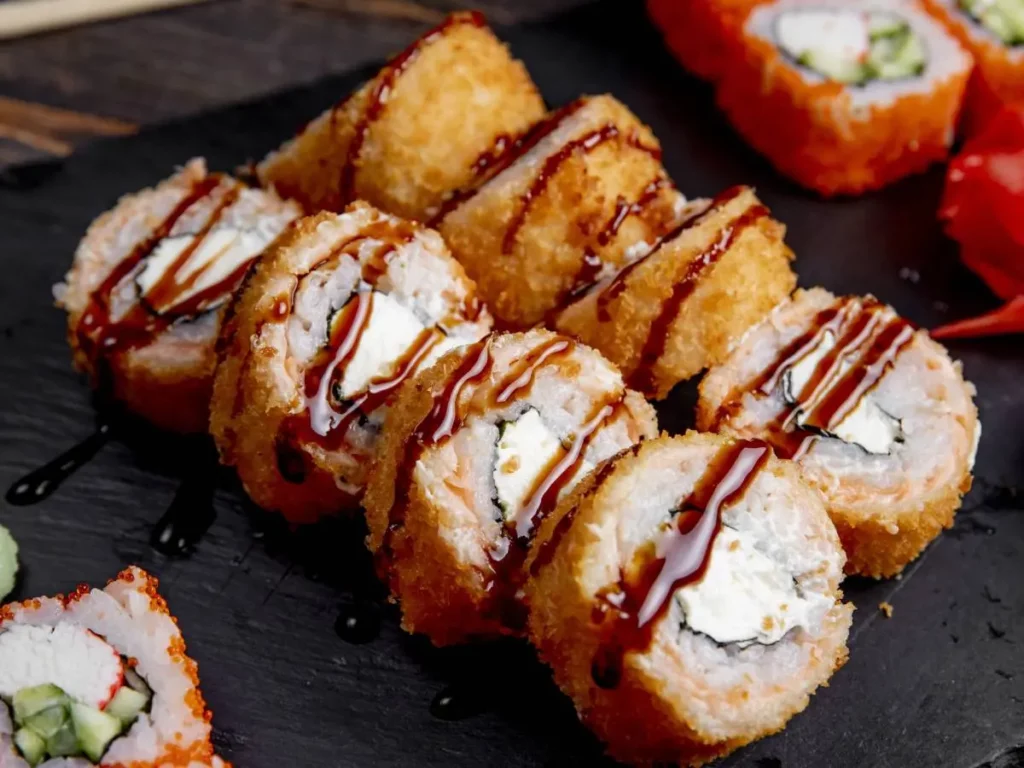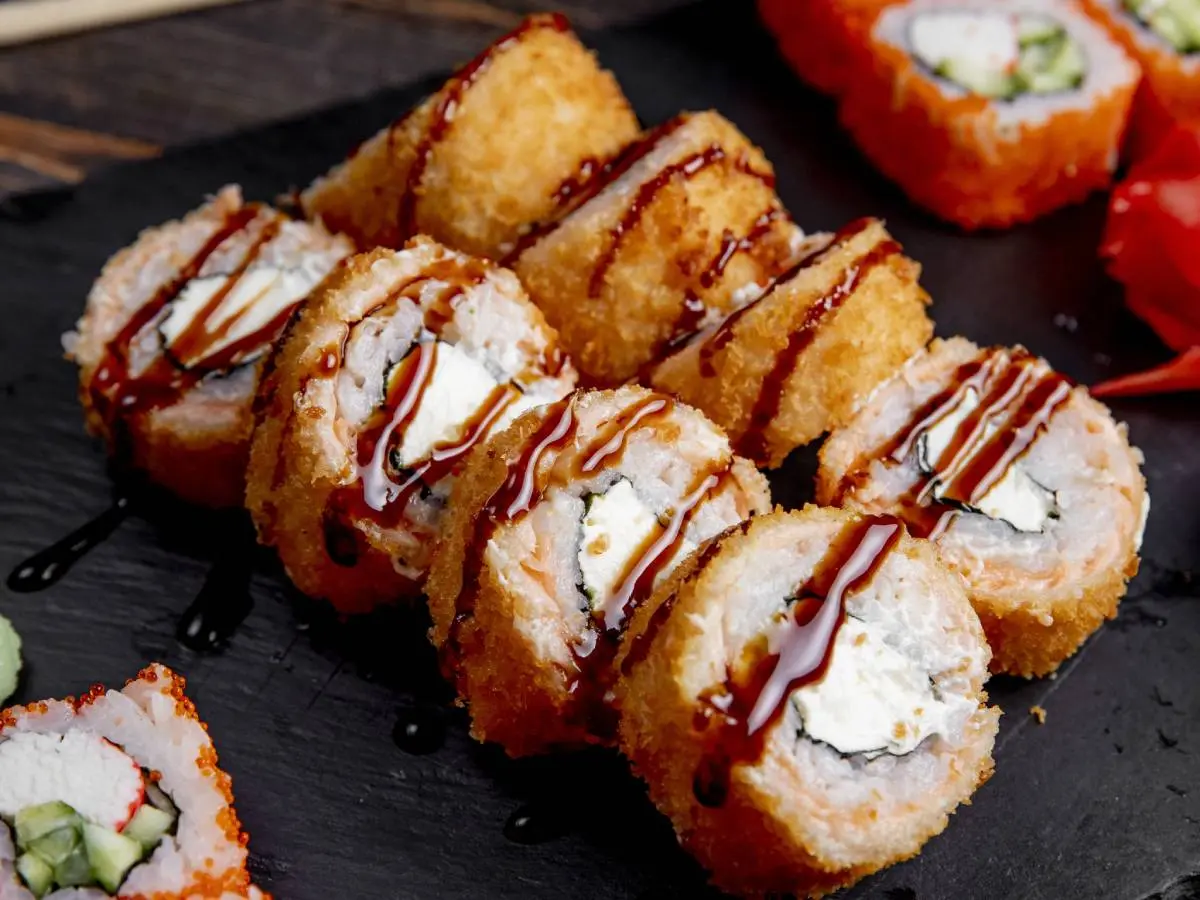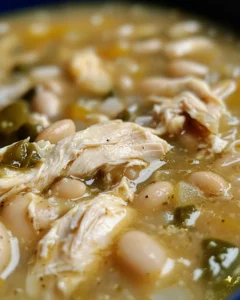What’s the crispy stuff on sushi? Sushi, a culinary masterpiece that has transcended its Japanese origins to become a global phenomenon, is celebrated not just for its fresh flavors but also for its delightful textures. Among these textures, the crispy elements play a pivotal role in transforming a simple sushi roll into an extraordinary sensory experience. This article delves deep into the heart of sushi’s crunchiness, exploring the ingredients that add that irresistible crisp, the methods to incorporate them into sushi, and how these elements influence the nutritional profile of the dish. From the traditional tempura flakes to innovative panko breadcrumbs, we embark on a culinary journey to uncover the secrets behind the crispy stuff on sushi, ensuring every sushi enthusiast can bring these techniques into their home kitchen.


Introduction to Sushi and Its Crispy Components
Understanding Sushi: A Culinary Art
Sushi, in its essence, is much more than just raw fish combined with rice. It’s a delicate art form where balance, texture, and flavor harmonize to create dishes that are as aesthetically pleasing as they are delicious. The introduction of crispy elements into sushi rolls adds a contrasting texture that elevates the eating experience, making it a dance of different sensations on the palate.
The Role of Texture in Sushi
Texture plays a crucial role in the enjoyment of food, and sushi is no exception. The interplay between the softness of the rice, the tenderness of the fish, and the crispiness of toppings or fillings brings about a complex mouthfeel that is both satisfying and intriguing. This contrast is not just a matter of taste but a carefully crafted aspect of sushi’s culinary identity.
Overview of Crispy Elements in Sushi
The crispy stuff on sushi can come from various sources, each adding its unique flavor and crunch. The most common include:
- Tempura Flakes (Tenkasu): Light and airy, these are bits of batter fried to perfection and sprinkled over or tucked inside sushi rolls.
- Fried Onions: Offering a sweet and savory crunch, fried onions can be used as a topping or a flavorful addition inside the roll.
- Panko Bread Crumbs: Known for their light, flaky texture, panko breadcrumbs are used to coat and fry certain sushi rolls, adding a golden crunch.
Each of these components not only adds texture but also layers of flavor that can complement the delicate taste of sushi. As we delve further into the article, we will explore how these crispy elements are prepared and integrated into sushi, ensuring that every bite is a memorable one.
The Crispy Stuff on Sushi: Ingredients and Preparation
Identifying the Crispy Elements
The journey to a crunchy sushi experience begins with understanding the key ingredients that contribute to that much-loved texture. Let’s dive into the specifics of each and how they’re prepared to add that special crunch to sushi.
Tempura Flakes (Tenkasu)
Tempura flakes, or tenkasu, are tiny, crispy bits of deep-fried batter that offer a light, airy crunch to sushi rolls. They’re a testament to the ingenious ways Japanese cuisine incorporates texture into dishes. Salmon sushi bake
- Ingredients and Quantities:
- 1 cup all-purpose flour
- 1 egg, beaten
- 1 cup ice-cold water
- Oil for frying
- Preparation Method:
- Combine the flour, egg, and ice-cold water in a bowl, mixing lightly to keep the batter lumpy.
- Heat oil in a deep fryer or a deep pan to 350°F (175°C).
- Drizzle the batter through a slotted spoon into the hot oil to create small droplets.
- Fry until golden and crispy, then remove and drain on paper towels.
Fried Onions
Fried onions add a sweet, savory, and crispy dimension to sushi that’s both unexpected and delightful.
- Ingredients and Quantities:
- 2 large onions, thinly sliced
- 1 cup milk or buttermilk
- 1 cup all-purpose flour
- Salt and pepper to taste
- Oil for frying
- Preparation Method:
- Soak the sliced onions in milk for at least an hour.
- Combine flour, salt, and pepper in a separate bowl.
- Heat oil in a deep fryer or pan to 375°F (190°C).
- Dredge the milk-soaked onions in the flour mixture and fry until golden brown and crispy.
- Drain on paper towels before using as a topping or inside sushi rolls.
Panko Bread Crumbs
Panko bread crumbs are known for their larger, flakier texture compared to regular breadcrumbs, offering a crunch that’s both satisfying and visually appealing when used in sushi.
- Ingredients and Quantities:
- Panko bread crumbs (as needed)
- Oil for frying
- Preparation Method:
- Heat oil in a pan over medium heat.
- Add panko bread crumbs to the pan, stirring constantly until they are golden brown.
- Remove from heat and let cool. Use as a coating for sushi rolls or as a topping for added texture.
Incorporating these crispy elements into sushi not only adds a delightful crunch but also layers of flavor that enhance the overall dining experience. Whether used as a topping or integrated within the roll, these ingredients ensure that each bite of sushi is a perfect blend of soft, tender, and crispy textures. As we move forward, we’ll explore the art of seamlessly adding these crunchy components to sushi, elevating it from a simple dish to a culinary delight.
What’s the crispy stuff on sushi?
Incorporating Crispy Elements into Sushi
The art of sushi making is as much about texture as it is about taste. Incorporating crispy elements into sushi requires a delicate balance, ensuring that the crunch complements rather than overwhelms the dish. Let’s explore the techniques that can add that perfect crunch to your sushi.
Techniques for Adding Crunch
- Inside the Roll: One of the most common methods to incorporate crispy elements is by adding them inside the sushi roll. This can be done by sprinkling tempura flakes, fried onions, or even panko directly onto the rice before rolling. This method ensures that the crispy texture is experienced with every bite, providing a delightful contrast to the softness of the rice and the tenderness of the fish.
- Topping the Sushi: Another popular technique is to use crispy elements as a topping. This is often seen in sushi types like nigiri, where a small pile of tempura flakes or panko is placed atop the fish, adding a crisp texture and an appealing visual element. In rolls, these ingredients can be sprinkled on top of the roll before slicing, ensuring that each piece has a bit of crunch.
Popular Sushi Rolls with Crispy Elements
- Crunchy Roll: The Crunchy Roll is a fan favorite, known for its satisfying crisp texture. Typically, it includes shrimp tempura and cucumber inside, with tempura flakes sprinkled liberally on top, all wrapped in a layer of sushi rice and nori. The roll is then drizzled with a sweet and tangy sauce, adding flavor as well as enhancing the crispy texture.
- Spider Roll: The Spider Roll is another example where crispy elements play a starring role. This roll features soft-shell crab tempura, providing a natural crunch. It’s often accompanied by avocado, cucumber, and sometimes lettuce, with panko or tempura flakes added for extra crispiness. A drizzle of spicy mayo or eel sauce can add a depth of flavor, making the Spider Roll a complex and delicious sushi option.
Incorporating crispy elements into sushi is not just about adding texture; it’s about creating a multi-sensory experience. The contrast between the soft, vinegared rice, the freshness of the seafood, and the crisp bite of the toppings or fillings makes each sushi roll a delightful surprise. As we continue to explore the world of sushi, it becomes clear that these crispy elements are essential in crafting a dish that is as enjoyable to eat as it is to look at. Next, we’ll delve into the nutritional considerations of adding these crispy components to sushi and explore gluten-free and vegan alternatives, ensuring that everyone can enjoy the crunch regardless of dietary restrictions.
Nutritional Considerations and Variations
While the crispy elements in sushi add a delightful texture and enhance the overall dining experience, it’s important to consider their nutritional impact. Additionally, with the rise of dietary restrictions and preferences, finding alternatives that cater to everyone’s needs is essential. Let’s explore the nutritional aspects of these crispy components and discuss gluten-free and vegan options.
Health Aspects of Adding Crispy Elements
Adding crispy elements like tempura flakes, fried onions, or panko can increase the calorie content of sushi due to the oil used in frying. However, when used in moderation, these ingredients can still be part of a balanced diet. It’s also worth noting that the method of preparation can affect the nutritional profile. For instance, air-frying or baking instead of deep-frying can reduce the oil content significantly, making the sushi less calorie-dense while retaining the crispiness.
For those monitoring their sodium intake, it’s advisable to be mindful of the seasonings used in these crispy elements, as they can contribute to the overall sodium content of the dish. Opting for low-sodium soy sauce or other seasonings can help manage this aspect.
Gluten-Free and Vegan Alternatives
- Gluten-Free Options: For individuals following a gluten-free diet, traditional panko and some tempura batters (which typically contain wheat flour) may not be suitable. However, gluten-free panko breadcrumbs are available in the market, offering the same light and airy texture without the gluten. Alternatively, crushed rice crackers can serve as a crunchy topping or filling, providing a similar crisp texture.
- Vegan Alternatives: Vegan diners can enjoy the crunch in their sushi without compromise. Tempura can be made using a vegan batter, substituting the egg for a mixture of water and flour or using commercial egg replacers. For a completely different approach, roasted quinoa or amaranth grains can add a nutty crispiness to sushi rolls, aligning with vegan dietary requirements.
Incorporating these crispy elements thoughtfully not only ensures that sushi remains an inclusive dish but also allows individuals to enjoy the textural contrast without straying from their dietary guidelines. As we adapt traditional methods to suit modern dietary needs, sushi continues to evolve, proving that this centuries-old cuisine can cater to the tastes and health considerations of a diverse global audience.
Next, we will address some frequently asked questions about the crispy stuff on sushi, providing insights and tips to help both novice and experienced sushi enthusiasts navigate the complexities of adding that perfect crunch to their sushi creations.
FAQs on Crispy Sushi Components
The addition of crispy elements to sushi raises several questions, especially among those new to sushi preparation or those looking to experiment with different textures and flavors. Here, we tackle some of the most frequently asked questions to demystify the process and encourage culinary exploration.
What’s the crispy stuff on sushi?
Frequently Asked Questions
- Can I make crispy sushi elements at home? Absolutely! Making crispy elements like tempura flakes, fried onions, or toasted panko is quite straightforward. With basic ingredients and simple cooking techniques, you can add that delightful crunch to your homemade sushi. For tempura flakes, mixing flour, water, and egg (or a vegan alternative) and lightly frying the batter will do the trick. Fried onions require nothing more than thinly sliced onions, flour, and a quick fry. As for panko, toasting it in a pan until golden brown is all it takes.
- Are there any alternatives to frying for a healthier option? Yes, there are healthier alternatives that still achieve a crispy texture. Baking or air-frying panko breadcrumbs or using dehydrated vegetables can offer a crunch without the added oil from frying. These methods significantly reduce the fat content, making your sushi a lighter option while still providing that satisfying texture contrast.
- How do I store leftover crispy elements? Storing leftover crispy elements properly is key to maintaining their texture. For tempura flakes and fried onions, once completely cooled, store them in an airtight container at room temperature. They should stay crispy for a few days. Toasted panko can also be stored similarly. If you notice they’ve lost some of their crunch, a quick toast in a dry pan or a few minutes in the oven can help revive them.
What’s the crispy stuff on sushi?
Enhancing Your Sushi Experience
Incorporating crispy elements into sushi not only adds a unique texture but also elevates the overall dining experience. Whether you’re making sushi at home or enjoying it at a restaurant, the contrast between the soft, vinegary rice, the freshness of the seafood, and the crispiness of toppings or fillings makes each bite a culinary delight. By understanding how to prepare and use these crispy components, as well as how to store leftovers for future use, you can enhance your sushi creations, making them even more enjoyable and satisfying.
In the next section, we’ll explore creative ideas for home chefs looking to experiment with crispy elements in sushi, offering inspiration for those eager to bring a new dimension to their sushi-making adventures. Is it better to bake salmon at 350 or 400?


